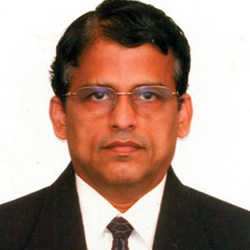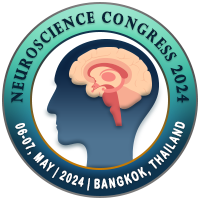
A V Srinivasan
DR. M.G.R Medical University, IndiaTitle: Sensory Modulation in Motor and Sensory Recovery of Central and Peripheral Lesions
Abstract
INTRODUCTION: The Somatosensory system is a complex network of neurons, synapses, and receptors,
through which we perceive and navigate our environment. The afferent sensory
system interacts via direct and indirect projections with the brain stem,
cerebellum, subcortical and cortical structures. This communication brings out
the motor sensory modulation in neurological rehabilitation in intermanual
referral of sensation and extinction of pain in the peripheral and central lesions
of somatosensory system. (stroke, hemineglect, brachialplexes, phantom limb, cancer
breast and cancer penis).
METHODOLOGY: All these patients were examined and
investigated in our Institution’s movement disorder clinic with basic
investigations, MRI and ENMG in all cases. All the patients were studied with vestibular
simulation and posterior column sensations. (pressure, vibration, movement, position,
and touch.
CASE STUDIES
(VIDEO SEGMENTS ACCOMPANY THIS PRESENTATION): Case Vignette 1 – Stroke: Three
patients, one with thalamic stroke and two patients with temparo parietal were
analysed. There was no intermanual referral to the ipsilateral normal leg. When
intense pressure was applied on the normal hand it resulted in extinction of
pain in the stroke side after one minute.
This intermanual referral of sensation only occurred after 3-4 months in
the paralysed hand and leg. The spatial organisation was poor, but the
localisation was present in the normal limb. The temparo parietal stroke
patient had hemineglect with left hemiplegia. The patient had left visual
neglect with left hemianopia with no auditory neglect. Absent sensory
perception in the left upper and lower limb with neglect. This patient had Anosognosia,
body neglect and somatoparaphrenia. Vestibular simulation test was done for
this patient. It clearly showed that the patient was able to touch the left arm
in whatever position the examiner kept the arm. Thus, proving the first case of
blind touch in world literature. Blind sight has already been well described.
Case Vignette
2 - Brachialplexes: 21-year-old girl who had total brachialplexes lesion was studied
at 6months, 1 year and 2 years. She had referred in a topographically organised
manner in the phantom limb on the ipsilateral side.
Case Vignette
3 - Amputation: Two patients (one with below elbow amputation and another with
knee amputation) showed intermanual referral of sensation within 10days. The
referred sensation of touch and vibration lacked spatial organisation and poor
localisation with a relatively high threshold.
DISCUSSION: Contralateral
referral of sensation was not found in normal subjects or in hemiparetic
patients without hemisensory loss. Neural mechanisms for perceptual alteration
not clear. The possible mechanism is due reactivation of pre-existing
connections linking the hands and legs. Pain and temperature sensations are not
referred because there are no commissural fibres. The sensory modulation in
spatial neglect was done with magnetic stimulation, neck vibration training and
repetitive auto kinetic simulation. Drug treatment is currently unsuccessful, and
this is the first case in the world literature where vestibular sensory
stimulation was useful in treating the Neglect in the stroke patients. It appears
that a decrease in somatosensory input to one cerebral hemisphere from the
contralateral hand allows responsiveness of neurons in this hemisphere to
moderately intense tactile stimuli on the ipsilateral hand to exceed perceptual
threshold (which does not normally occur). Intermanual referral and extinction
of pain sensation was excellent in special organisation and localisation in
brachialplexes, whereas it was poor in amputation and stroke. The pain relief
occurred immediately in brachialplexes and amputation within 7 days, whereas it
was 3-4 months in stoke.
CONCLUSION:
1) First unconscious sensory perception in a stroke patient with neglect has
been described. 2) Sensory modulation helped in motor sensory recovery in
stroke patients. 3) Intermanual referral of sensations occurred within 10days in
a topographically organised manner in brachialplexes lesions but not in
amputation and stroke. 4) Intermanual referral and extinction of pain occurred
after a delay of 3-4 months in stroke.
Biography
He is Emeritus Professor in the Tamil Nadu Dr. M.G.R. Medical University; Former Adjunct Prof.–IIT (Madras) – (Bio – Technology) and Visiting Professor in Cleveland –Ohio – USA; Hershey Medical College, USA and Former Adjunct Prof. –IIT (Madras) –(Bio– Technology)

